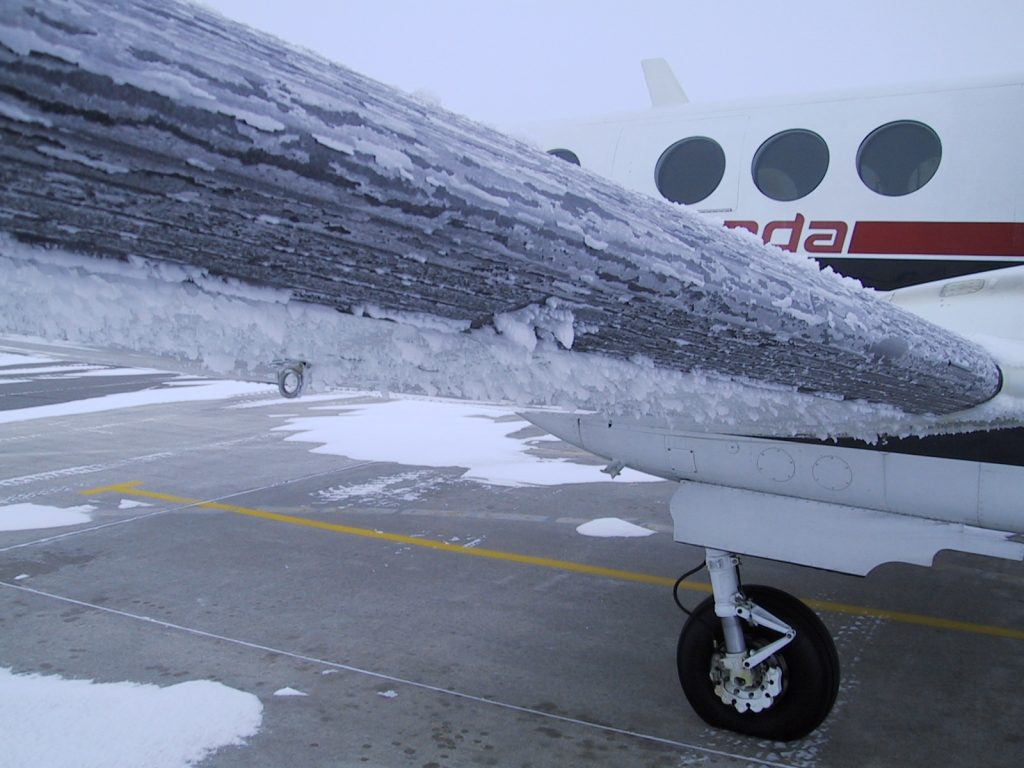‟London Control, Grosvenor Zero Three Bravo, request descent!ˮ my voice on the R/T may have sounded calm, but I felt far from it. The reassuring voice in my headphones returned with;
‟Standby Grosvenor Zero Three Bravo, maintain Flight Level Niner Zero…ˮ
My situation was not good and I knew it. At cruising altitude, nearly nine thousand feet above the Pennines in solid clag. I looked again at the Airspeed Indicator, hmmmm… nearly back to blue-line speed and I had full power on… A quick scan of the VSI showed the needle dipping slowly, the aircraft was just beginning to lose altitude and I knew what was coming next. I twisted slightly in my seat and shone my torch through the side window of the little cockpit – Ughhh! I mentally winced – the air intake of the left engine was a mass of ice and snow, clogged. I didn’t need to look at the right engine, it would be the same. I could see the horizontal snow streaking past the glass outside, a blizzard. Also I was aware of the irregular banging noise on the fuselage as ice was being shed from the props – the electric anti-ice heaters were doing their job. I had just tried to de-ice the leading edges of the wings again with the inflatable rubber boots, but the effect was negligible – the ice build-up was fast and furious. All of this took only seconds, before I decided I couldn’t wait any longer.

‟London. Grosvenor Zero Three Bravo descending… leaving level nine zero, erm… looking for lower…ˮ how much lower I didn’t know, but I knew it was impossible to stay up here. Maybe I could get below the freezing layer and some of this damned ice would melt… fat chance of that, I thought miserably. From the forecast it was freezing on the hills tonight over the whole route. Damn! I can’t let it go any slower, must maintain the airspeed above… the… blue… line. I trimmed again so she would fly hands off. A weather radar would be nice I mused. Oh to have a weather radar, but this ship is too small and too cheap for that, the R/T came to life again.
‟Grosvenor Zero Three Bravo, London. Sorry about that. Was on the phone, are you unable to maintain altitude? Be aware you have loud background noise on your transmissionsˮ.
‟Yes London, THAT’S THE ICE! Against the hull – off the props. Erm… We’ve picked up a load of ice here and full power on, we’re going down… Unable to maintain cruise level and request a left turn… ahhh, sixty degrees, maybe we can get clear of the weather?ˮ it was a long transmission and I knew it, but it was a big story for me. I thought, why do I keep saying ‟Weˮ, there’s only me up here….!? He was quick to reply.
‟Turn left, heading 280 degrees Grosvenor, are you declaring an emergency?ˮ
*
It is a well-known fact that ice and aviation don’t mix well. In reality it is worse than that, Ice is a killer. The pages of aviation history books are littered with the reports of hull losses due to icing. Airframe ice and/or engine ice, during winter operations the dangers are serious and should not be underestimated. If the atmospheric conditions are right, ice will accumulate on cold airframes and in engine intakes with adverse effects on aircraft performance. An example comes immediately to mind; Air Florida Flight 90 in 1982 – a B737 which stalled after take-off and crashed into the Potomac River in Washington, killing 74.
Back in the late 1980s I worked as an Air Taxi pilot at Manchester for a couple of years, just prior to joining the airlines. It was varied and interesting work and in those days we operated all of our flights as single crew. This was in the days before regulations made two crew ops (or solo only with a working autopilot) mandatory. Not only did we fly alone, we also had to fly the aircraft manually on instruments. They were light piston engined twins with propellers and as we flew in all weathers in the UK, we knew all about icing. There was one regular mission which we used to fly and I remember it well. The company had the contract to fly from Heathrow to Prestwick every Wednesday night. It was technically a freight flight, but the cargo itself was not heavy – it was the printing plates for the Sunday (and Radio) Times magazine. Bear in mind this was in the days before the internet. The originals were made in London and as the media organisation were time sensitive – always up against a deadline – they had to ship to Scotland on the Wednesday night without fail. A motorcycle courier would bring the 3 kilogramme package to Heathrow private jet terminal where we would be waiting.
During the summer months, I recall this flight being very popular with all the pilots – we positioned empty from Manchester to Heathrow and then after delivery in Prestwick, empty back to base. It was a doddle. Winter time was another story, nobody volunteered and we all had to take our turn. Come October 1987 and it was my turn – unlucky me. Flying unpressurised propeller aeroplanes the length of the UK below 10,000 feet at night in IMC was not funny. One saving grace was that we were operating at light weights, the other was that it improved our instrument flying skills. We didn’t blink much.
The icing protection systems which we had on the light twins consisted of rubber boots on the leading edges of the wings and electric heating elements in the propeller blades. In icing conditions, the prop de-ice was switched on routinely of course as an anti-ice measure, but the wing de-ice boots were different. As ice built up on the leading edges of the wings it was important not to use the de-icing boots too early. The reason was that if there was only a light coating of ice, then under certain conditions it was possible for the rubber boots to expand but not break the ice away. This would leave an enlarged frozen bubble on the outside of which more ice would form. The danger then would be that there could be a huge accumulation of ice which was impossible to remove… On this particular nightflight, although I did not believe I had made this mistake, I was certainly in a bad situation where the airframe was picking up more ice than it could cope with.
The increased drag from the ice and reduced power from the engines combined to have such a negative effect on performance that keeping level flight in these conditions was not possible, I/we had to get out of cloud.
Am I declaring an emergency? I thought for about half a second… yes good idea! It was weird. Part of me felt guilty for causing a nuisance, after all I should have been able to maintain altitude. I was shocked that it was not possible, it had never happened before. These days in Human Factors research it’s called the ‘Startle Effect’, but in those days we didn’t know so much.
‟Affirm London a Pan call please, Pan-Pan Grosvenor Three Bravo descending, unable to maintain Cruise Alt due to ice…ˮ now steady on the heading, surely we can get out of this.
‟Roger Grosvenor Three Bravo! The base of the airway is flight level six zero and you have no traffic below. Cleared descentˮ.I wanted to hug him, instead I focused on flying the dials. Slowly rolling into the turn, passing 8,300 on the altimeter, VSI nearly 500 feet per minute down and still at blue-line on the ASI… The controller came through again, ‟…and the Regional pressure setting is Niner Eight Zero Millibarsˮ. Very kind of him. I would need this as I dropped out of the bottom of the airway to judge my height above terrain. TERRAIN…!! Argghhh, the thought had me looking again at the safety altitude on the chart – hmmm, present position, just over four thousand feet. 980mbs, a typical low QNH in the winter, I set it on the standby altimeter – approaching 7,000 feet at this time.
A quick glance at the engine gauges showed maximum power with alternate air selected. Of course ‘ALT AIR’ reduced the power output, but as the normal air intakes were blocked solid, there was no choice. I recalled stories about pilots from the old days playing with the engine fuel mixtures separately on each motor to make them backfire to blast the ice out of the intakes. Jeez, I hope it doesn’t come to that, (rising panic…) I DON’T EVEN KNOW HOW TO DO IT… Can’t risk an engine failure here.
Suddenly the horizontal snow stopped snowing – I breathed heavily, unaware that I had been holding my breath. We’re showing warmer air on the OAT gauge… then all of a sudden, CLEAR! We are in the CLEAR! Out of cloud, I can see the lights of a city below, Yorkshire I am sure – Leeds, maybe. The snow has definitely stopped and I press the de-ice boots switch again. Looking hard with my torch along the leading edge of the left-wing I see the ice breaking away as the rubber boots fill with high pressure air – YES! And I can FEEL the ship start to perform better now, ASI needle rising and we are flying level. No descent on the VSI, phew! My beautiful little aeroplane…! Come on Hun, you can do it girl…! COME ON!!
‟LONDON, WE’RE CLIMBING AGAIN!ˮ I need to tell somebody, he replied immediately,
‟Roger Grosvenor Zero Three Bravo, maintain Flight Level Seven Zero – call Scottish Control now on frequency one two six decimal three, good luckˮ.
I thanked him sincerely, cancelled the Pan and changed the radio over. I noted that we were going faster and faster now. Soon there would be a surfeit of power, luxury. I was relieved for sure, checking the weather again I could see we should be in the clear all the way to Prestwick. I looked forward to a celebratory cup of hot coffee!
Oh, the joys of the Air Taxi pilot in the winter.
© James McBride January, Kaunas, Lithuania.
* ‟Blue-line speedˮ = Best rate-of-climb speed for a twin-engine aircraft with one engine inop. (Also known as safe single-engine speed).







